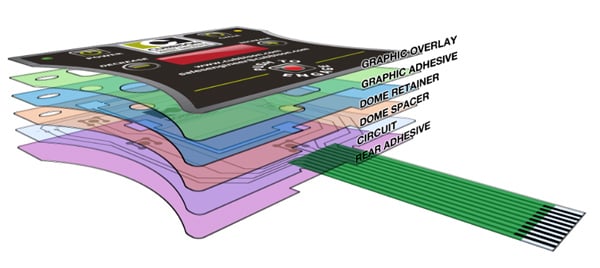Top Advantages of Incorporating a Membrane Switch Into Your Electronic Tools
Top Advantages of Incorporating a Membrane Switch Into Your Electronic Tools
Blog Article
Recognizing the Functionality of Membrane Layer Switches for Interface Devices
The capability of membrane layer switches stands for a significant innovation in interface design, incorporating effectiveness with visual flexibility. These buttons run via a multi-layered framework that equates user interactions right into electrical signals, allowing for both small formats and resilience against environmental aspects. As sectors progressively prioritize individual experience, understanding the nuances of membrane switch innovation comes to be crucial. What ramifications do these innovations hold for future applications, and just how might they redefine individual communications throughout different tools?
What Are Membrane Buttons?
Membrane buttons are innovative user interface gadgets that help with customer interaction with digital devices. These versatile parts consist of several layers, consisting of a graphic overlay, spacer, and a published circuit layer. The layout enables a seamless combination right into numerous digital tools, improving both the aesthetic and practical facets of interface.
Membrane switches are commonly used in a wide variety of applications, from family home appliances to commercial equipment and medical tools. Their building usually includes a slim profile, making them a suitable choice for small styles. The responsive responses provided by these switches can be crafted to meet particular user preferences, making certain reliable interaction in between the individual and the device.
Longevity is an additional substantial advantage of membrane buttons, as they are immune to dirt, dampness, and chemicals, which boosts their life-span sought after environments. In addition, these switches can be personalized in terms of form, size, and graphic style, enabling branding and user-specific features. Generally, membrane layer switches over represent a useful service for boosting customer experience in digital tools, incorporating functionality with aesthetic charm in a reliable way.
How Membrane Layer Switches Job
Operating on a straightforward principle, membrane layer switches use a split building to sign up individual input properly. Each switch includes numerous layers, including a published circuit layer, a spacer layer, and a leading visuals layer, which are developed to function with each other perfectly. When a user presses the leading layer, it compresses the spacer layer, bringing the conductive elements of the circuit layer right into contact with each various other.
This contact develops a shut circuit, indicating the device to perform a details function. The style enables various configurations, including tactile responses, which can improve the user experience by supplying a physical sensation upon activation. The products used in membrane buttons frequently include versatile substrates, such as polyester or polycarbonate, which make sure longevity and durability against wear and tear.

Secret Advantages of Membrane Layer Switches

Another considerable benefit is their density. Membrane switches informative post are slim and light-weight, which makes it possible for makers to save room in their devices without compromising functionality. This function is specifically helpful in applications where weight and quantity are critical considerations.
Additionally, membrane switches are resistant to dust, moisture, and chemicals, enhancing their longevity. This resilience extends their life expectancy and decreases the demand for frequent replacements, causing price financial savings gradually.
Additionally, the responsive feedback given by membrane layer buttons can be optimized to enhance customer interaction. They can include features such as elevated buttons or audible clicks, improving functionality and individual experience.
Applications Throughout Industries
Customer user interface tools using membrane switches prevail in a vast range of sectors, showcasing their versatility and performance. Membrane Switch. In the medical industry, membrane buttons are important to gadgets such as diagnostic devices and person monitoring systems, where their sturdiness and simplicity of cleansing are vital for keeping hygiene requirements. Likewise, in the auto industry, these switches are employed in dashboard controls and infomercial systems, giving a streamlined and modern-day useful site interface for individuals.
In addition, the customer electronics market gain from membrane layer switches in home appliances and handheld devices, where small layout and user-friendly user interfaces boost customer experience. Industrial applications also take advantage of membrane layer changes for control board in equipment and automation systems, emphasizing their robustness and resistance to rough atmospheres.
In the aerospace and defense industries, membrane layer switches are utilized in cabin controls and tools, where dependability and efficiency under severe problems are vital. In addition, the gaming sector progressively integrates membrane layer buttons in controllers and arcade makers, adding to an engaging customer experience. In general, the versatility of membrane switches over allows their prevalent use across many sectors, underscoring their relevance in contemporary individual interface design.
Future Trends in Membrane Layer Change Innovation

Additionally, the use of advanced products, such as polycarbonate and polyester movies, is anticipated to climb, providing improved resilience and resistance to ecological stress factors. These products add to the total durability of membrane switches, making them appropriate for harsher commercial applications.
In addition, the unification of clever technology, consisting of IoT connection, will allow membrane layer switches to interact with other gadgets and systems, assisting in an extra interactive user experience. This fad straightens with the expanding demand for wise devices throughout numerous industries, from medical care to consumer electronic devices.
Last but not least, customization choices are expected to increase, allowing producers to develop bespoke options tailored to specific individual requirements and preferences. These developments will certainly place membrane buttons as important parts in the development of interface innovation.
Final Thought
In final thought, membrane layer changes stand for a pivotal development in individual interface technology, providing a dependable and flexible option for varied digital applications. Their split building and construction facilitates small layout, while attributes such as responsive feedback boost customer communication. The resilience versus ecological factors additionally strengthens their energy across multiple industries. As developments in product science and touch picking up technologies continue, the functionality and applicability of membrane switches are expected to increase, reinforcing their importance in modern-day digital gadgets.
Report this page